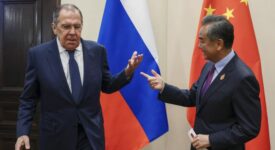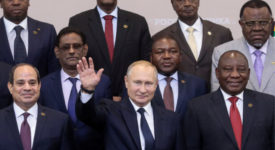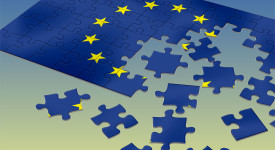The outbreak of the Crimean conflict in 2014 reaffirmed two things – that the divide between Russia and the West remains huge and also that 25 years after the dissolution of the USSR, Russia has not abdicated from the imperial ambitions of its predecessor. Today it seems that Russia and the West are where they were before 1991 – ripe for another lap of confrontation. Unfortunately, the current divide might be even more complex than in the times of the USSR – in the absence of any motivation to build a constructive dialogue, the level of spite and hatred has skyrocketed. Regrettably, the outbreak of ideological confrontation is to a large extent due to aggressive Russian behavior based on distortion of information and disinformation.
The new era in the relationship between the West and Russia began with the Euromaidan in Kiev, which dramatically changed the course and essence of the Russian anti-Western/European propaganda. In a very short period of time, three important information outlets appeared – the Rossiya Segodnya – multilingual news agency that has become the main outlet of Russian propaganda for external audiences, the Sputnik news agency operating in more than 30 languages, and another Russian news website LifeNews, consisting of a news website and 24-hour television channel, emerged.
These three information outlets are a remarkable example of very smart, flexible and sophisticated disinformation targeting audiences outside Russia, whereby this also predetermines both methods of delivery and further dissemination of (dis)information. These outlets rely heavily on quasi-argumentative discourse, avoiding outright distortion, fighting rhetoric or threats to turn other countries “into radioactive ash”. Instead, the method is to discredit both the US and the EU “softly” by providing an “alternative opinion” and tacit accusation of the “other side” for not disclosing the entire truth.
Moreover, the feel of “objectivity” is created by the appearance of foreign journalists, which stands in sharp contrast to European mass media that tends to rely on domestic resources. The catch, however, is that these “independent” journalists are collected from either open or tacit admirers of Vladimir Putin. Anti-Western/European sentiments among the Russian audience are also being triggered by pseudo-historians and writers who enjoy unconditional support from the Kremlin. This group could be supplemented by Russian neo-fascist thinker Alexander Dugin whose task was to establish close ties with European far-right and neo-Nazi groups as Moscow’s “European allies”.
According to Russian journalist Kseniya Kirillova, Russian propaganda aims to weaken critical thinking, create an image of the enemy, link all internal problems to external factors, emphasize the consolidation of society in the face of a military threat and create the image of Vladimir Putin as the only leader capable of withstanding the military threat. However, among the most dangerous features of the new wave of propaganda is the cultivation of militarism and Stalinism among Russians, with a special emphasis on the younger generation. The Kremlin ultimately aims to morally prepare Russians for a potential war with the West, which bitterly resembles the Soviet experience.
‘The ‘Trump Cards’ of the Russian Propaganda and Disinformation Operations’ –
Analysis by Sergey Sukhankin – Barcelona Centre for International Affairs (CIDOB).
(The Analysis can be downloaded here)







